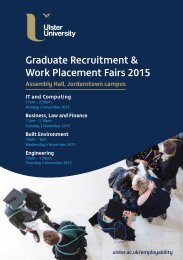Public Attitudes to Peace Walls (2015)
1RRkqqy
1RRkqqy
Create successful ePaper yourself
Turn your PDF publications into a flip-book with our unique Google optimized e-Paper software.
<strong>Public</strong> <strong>Attitudes</strong> <strong>to</strong> <strong>Peace</strong> <strong>Walls</strong> (<strong>2015</strong>)<br />
Survey Results<br />
Ulster University<br />
Table 26: If the <strong>Peace</strong> Wall in your community remains, what effect will it have on the following?<br />
Total (%) Protestant (%) Catholic (%)<br />
Jobs in this area 76 78 76<br />
Relations between the two communities 68 68 70<br />
Business investment in this area 65 67 66<br />
Community safety 68 69 68<br />
Government investment in this area 62 65 61<br />
Tourism <strong>to</strong> this area 66 69 66<br />
Access <strong>to</strong> services like health, education and leisure 77 78 78<br />
The image of Northern Ireland abroad 63 70 62<br />
People’s health and wellbeing 68 72 67<br />
Finally, the participants were asked <strong>to</strong> consider whether they thought there would be a time in<br />
the future when there would be no peace walls within their area (Table 27). The largest number<br />
of people (41%) thought that there would be an occasion in the future when all the peace walls<br />
would be dismantled. However, a further 41% were of the view that the peace walls would always<br />
be a part of the built environment. Interestingly, more Catholics (48%) than Protestants (27%)<br />
were more likely <strong>to</strong> believe that the peace walls would be taken down in the future.<br />
Table 27: Can you envisage a time when there will be no <strong>Peace</strong> <strong>Walls</strong> in<br />
this area?<br />
Total (%) Protestant (%) Catholic (%)<br />
Yes 41 27 48<br />
No 41 56 34<br />
Don’t know 17 17 18<br />
Since the announcement of TBUC, the Northern Ireland Executive has appeared <strong>to</strong> be divided on<br />
many issues and this may be reflected in survey responses. Disputes over the route of a parade<br />
in North Belfast led <strong>to</strong> widespread rioting and the establishment of a protest encampment. Interparty<br />
talks <strong>to</strong> address contentious issues chaired by Richard Haass and Megan O’Sullivan broke up<br />
in acrimony and without agreement in late 2013. Additional disagreements over budgets led <strong>to</strong><br />
further talks in 2014. Apparent success proved insufficient <strong>to</strong> prevent further polarisation during<br />
<strong>2015</strong>. Parading disputes and allegations of renewed paramilitary activity led <strong>to</strong> further talks in<br />
Autumn <strong>2015</strong>. Uncertainty in politics has been matched by greater tension in inter-community<br />
relations at local level. Engaging communities in a shared vision of safety has proved challenging<br />
with suggestions that TBUC has lacked urgency and priority and can be detected in survey<br />
responses.<br />
24




